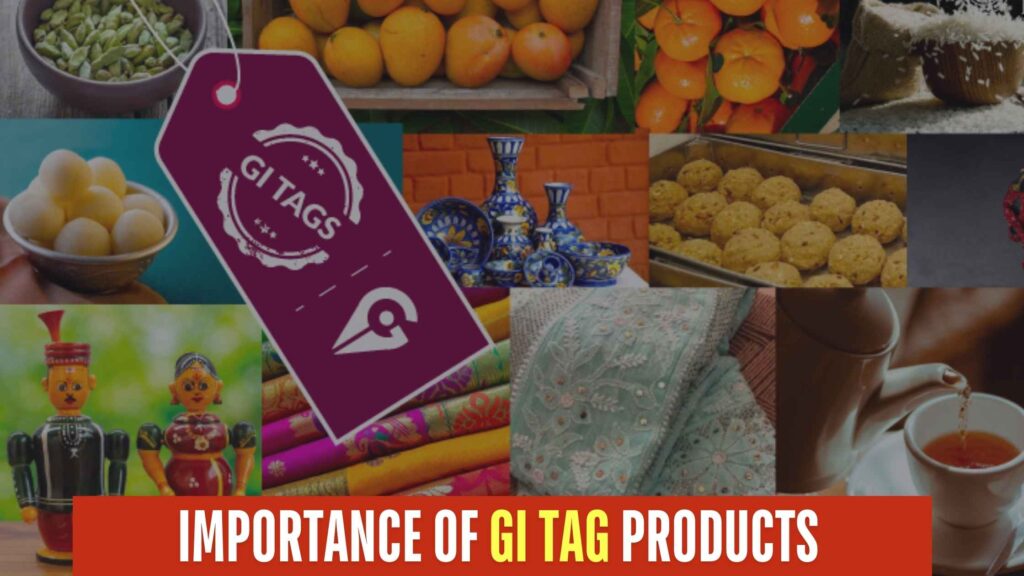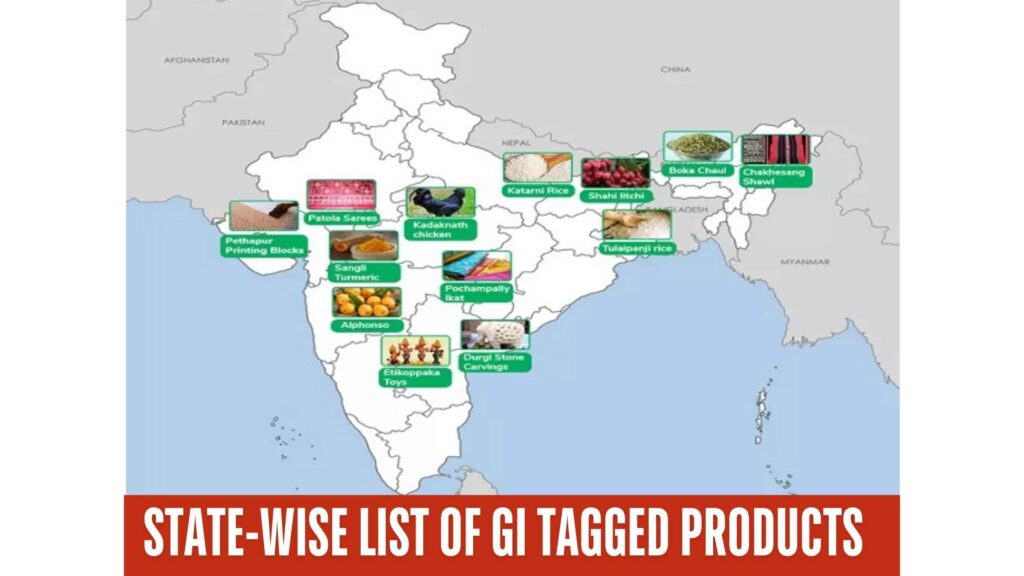GI Tag Products in India: Statewise Popular GI Tag Products (Full Guide)
Geographical Indications (GI) tag products in india are distinctive signs used on products that have a specific geographical origin and possess qualities or a reputation inherent to that location. In India, the Geographical Indications of Goods (Registration and Protection) Act, 1999, governs the registration and protection of GI tags products in india. These tags play a crucial role in recognizing the unique identity of regional products, preserving traditional knowledge, and promoting economic prosperity in local communities.
India’s diverse cultural heritage and varied climates have given rise to a plethora of unique products, each rooted in its specific region. From the aromatic teas of Assam to the intricate handicrafts of Tamil Nadu, GI tag products in india reflect the rich tapestry of India’s traditions and innovations.
Importance of GI Tag Products in India

Geographical Indication (GI) tags play a crucial role in preserving India’s rich cultural heritage and boosting the economy. They not only safeguard traditional products but also enhance their global recognition, ensuring fair economic returns to local producers and artisans.
Key Benefits of GI Tags Products in India:
- Preservation of Cultural Heritage: GI tags products in india help protect traditional knowledge, practices, and craftsmanship, ensuring they are passed down through generations.
- Economic Boost for Local Communities: By enhancing the market value of regional products, GI tags provide better income opportunities for artisans and farmers.
- Brand Recognition in International Markets: GI-tagged products enjoy a premium status in global trade, helping boost Indian exports.
- Protection Against Duplication: These tags provide legal protection, preventing the misuse of a product’s name and ensuring authenticity.
- Promotion of Tourism: GI-tagged products often draw tourists, contributing to the local economy through cultural and heritage tourism.
Significance of GI Tag Products in India
Geographical Indication: GI tag products in india hold significant value as they are closely linked to a region’s heritage, culture, and tradition. These tags certify the authenticity and quality of the product, ensuring that only goods produced in a specific region can use the GI name.
Why GI Tag Products Matter:
- Protection of Traditional Knowledge: GI tags safeguard traditional knowledge and techniques passed down through generations, preserving cultural heritage.
- Economic Growth and Branding: They enhance the market value of products, enabling producers to brand their goods as premium, boosting sales and revenue.
- Consumer Trust and Quality Assurance: GI tags assure consumers of the product’s quality and authenticity, increasing buyer confidence and loyalty.
- Legal Protection Against Imitation: They provide legal protection against unauthorized use or imitation, protecting producers from unfair competition.
- Promotion of Regional Identity: GI tag products promote the unique identity of a region, attracting tourism and encouraging local development.
State-wise List of Geographical Indications: GI Tag Products in India

India’s diverse cultural and geographical landscape is reflected in its vast array of GI-tagged products. These products, unique to specific regions, highlight the country’s rich heritage and traditional craftsmanship. Discover the state-wise distribution of these exclusive items that symbolize India’s legacy and local expertise.
Andhra Pradesh:
- Srikalahasti Kalamkari: Traditional hand-painted textiles known for their intricate designs.
- Kondapalli Bommalu: Wooden toys crafted in the Kondapalli region.
Assam:
- Assam Tea: Globally renowned for its robust flavor and rich color.
- Muga Silk: A unique silk variety known for its natural golden sheen.
Bihar:
- Madhubani Paintings: Traditional art form characterized by intricate patterns and vibrant colors.
- Bhagalpuri Silk: Silk textiles known for their elegance and fine quality.
Chhattisgarh:
- Bastar Dhokra: Ancient metal casting art form using the lost-wax technique.
- Bastar Wooden Craft: Handcrafted wooden artifacts reflecting tribal culture.
Goa:
- Feni: A popular local spirit made from cashew apples or coconut sap.
- Goan Khaje: Traditional sweet made from jaggery and ginger.
Gujarat:
- Patola Saree: Exquisite handwoven sarees known for their vibrant colors and intricate patterns.
- Kutch Embroidery: Distinctive embroidery style featuring bold motifs and mirror work.
Haryana:
- Phulkari: Traditional embroidery art characterized by floral motifs.
- Bhiwani Rugs: Handwoven rugs known for their durability and unique designs.
Himachal Pradesh:
- Kullu Shawl: Handwoven shawls adorned with colorful patterns.
- Chamba Rumal: Embroidery art form depicting intricate scenes on handkerchiefs.
Jharkhand:
- Sohrai Khovar Painting: Traditional mural art using natural pigments.
- Jharkhand Lac Bangles: Vibrant bangles made from natural resin.
Karnataka:
- Mysore Silk: Luxurious silk sarees known for their purity and craftsmanship.
- Bidriware: Metal handicraft featuring intricate silver inlay work.
Kerala:
- Aranmula Kannadi: Unique metal-alloy mirrors handcrafted in Aranmula.
- Navara Rice: A medicinal rice variety endemic to Kerala.
Madhya Pradesh:
- Chanderi Fabric: Lightweight and glossy fabric known for its fine texture.
- Bagh Prints: Hand block printing technique using natural dyes.
Maharashtra:
- Paithani Saree: Handwoven silk sarees with rich zari work.
- Warli Painting: Tribal art form depicting daily life and nature.
Manipur:
- Manipuri Sankirtana: A ritual singing, drumming, and dancing art form.
- Shaphee Lanphee: Traditional handwoven shawls with symbolic motifs.
Meghalaya:
- Meghalaya Lakadong Turmeric: High-curcumin turmeric variety known for its vibrant color and medicinal properties.
- Meghalaya Khasi Mandarin: Juicy and aromatic citrus fruit native to the Khasi hills.
Mizoram:
- Mizo Puanchei: Traditional handwoven shawl with vibrant patterns.
- Mizo Chilli: Fiery chili variety integral to Mizo cuisine.
Nagaland:
- Naga Mircha: One of the hottest chilies in the world, also known as King Chili.
- Chakhesang Shawl: Handwoven shawls with distinct geometric patterns.
Odisha:
- Odisha Pattachitra: Traditional scroll painting known for its intricate details.
- Konark Stone Carving: Exquisite stone sculptures inspired by the Sun Temple.
Punjab:
- Punjab Phulkari: Embroidery art featuring floral designs on fabric.
- Amritsar Woolen Carpets: Hand-knotted carpets known for their quality and designs.
Rajasthan:
- Kota Doria: Lightweight cotton sarees with square patterns.
- Blue Pottery of Jaipur: Distinctive pottery known for its eye-catching blue glaze.
Sikkim:
- Sikkim Large Cardamom: Aromatic spice cultivated in the Himalayan region.
- Dalle Khursani: Hot cherry pepper known for its pungency.
Tamil Nadu:
- Kanchipuram Silk: Premium silk sarees renowned for their elegance and craftsmanship.
GI Tag and Rural Development

Geographical Indication (GI) tags significantly contribute to rural development by empowering local communities and preserving traditional livelihoods. By recognizing region-specific products, GI tags enhance the value and marketability of goods, leading to sustainable economic growth in rural areas.
How GI Tags Support Rural Development:
- Employment Generation: GI-tagged products create job opportunities for local artisans, farmers, and producers, reducing rural migration.
- Increased Income and Profitability: By protecting the uniqueness of regional products, GI tags allow producers to charge premium prices, increasing their income.
- Encouragement of Local Entrepreneurship: GI tags inspire local entrepreneurs to innovate and expand traditional businesses while maintaining cultural authenticity.
- Skill Preservation and Cultural Identity: They help preserve traditional skills and cultural practices, fostering a sense of pride and identity among rural communities.
- Sustainable Development: GI-tagged products promote sustainable agricultural practices and eco-friendly production methods, contributing to environmental conservation.
Frequently Asked Questions (FAQ) on GI Tag Products in India

What is a GI Tag Products in India?
A GI (Geographical Indication) tag is a certification given to products that are native to a specific geographical region and possess qualities, reputation, or characteristics unique to that location.
Why is a GI Tag important?
GI tags protect the authenticity and originality of traditional products, preventing unauthorized use, boosting the product’s value, and supporting local artisans and farmers.
Who grants GI Tags products in India?
In India, the Geographical Indications Registry under the Department for Promotion of Industry and Internal Trade (DPIIT) grants GI tags.
How many GI-tagged products are there in India?
As of 2024, there are 603 registered GI tag products in India, covering agricultural goods, handicrafts, textiles, and foodstuffs.
Can GI-tagged products be exported?
Yes, GI-tagged products can be exported, and their unique identity often enhances their demand in international markets.
Are GI tags permanent?
No, GI tags are not permanent. They are granted for an initial period of 10 years and can be renewed indefinitely.
Can a product have multiple GI tags?
No, a product can only have one GI tag, which corresponds to the specific region associated with its unique characteristics.
How can I verify a product’s GI tag?
You can verify a product’s GI tag by checking the official website of the Geographical Indications.
Registry:
https://ipindia.gov.in/registered-gls.htm
Who can apply for a GI tag?
Producers, associations of persons, organizations, or authorities representing the interests of producers of a specific product can apply for a GI tag.
What is the significance of state-wise GI tag distribution?
State-wise distribution showcases the rich cultural and traditional diversity of India, highlighting each region’s unique heritage and expertise.
If you want to learn import-export from basics to advanced, including company formation, import-export documents, product research in exports, finding foreign buyers, pre-shipment and post-shipment documentation, GST in exports, payment terms, Incoterms, and more, then watch this 7-hour video by Mr. Keshav Dimri, a successful exporter and brilliant marketer working since 2017.






